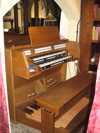 Bingham Bingham
St Mary and All Saints
Organ
The original maker of the pipe organ is unknown.
It was originally situated in the north transept. In the middle of the 19th
Century, though, Sybil Miles, daughter of Robert
Miles, was appointed organist. At that point the organ was moved into the
extension, now the clergy vestry, which was
built expressly to accommodate it in 1863. (Maybe Miss Miles felt this
would be better and prevailed upon her father, or maybe the idea was to open
up the north transept.) This resiting necessitated the removal of the glass
in two of the windows so that the organ could
sound into the church.
We do not know what the organ sounded like before, but the move
cannot really have improved the sound of the instrument. The opening into
the chancel was adequate, but the one into the nave was
too small to allow the organ to be heard properly. It never gave a very good
sound after this.
The organ was rebuilt in 1914 by Lloyd & Co of Nottingham, and again in
1973 by Henry Groves (also of Nottingham) when electric action was installed.
 The
new The
new
electronic organ |
By the mid-1980s it was again having problems. There had been water ingress
which had damaged the mechanism, and the electrics were beginning to fail.
In 1987 the reed stops were said to be ‘in deplorable condition, and
sound accordingly’. A major rebuild, or preferably replacement in a different
place, was recommended. Financial considerations did not allow this, and the
organ continued to deteriorate. By the mid-1990s there were a number of notes
in several stops that would not work, and by 1997 it was felt to be unplayable.
It was decided to replace the organ with a good-quality modern electronic
instrument. The pipe organ was disposed of and, after the church had used a
borrowed instrument for a time while money was raised, an ‘Eminent’ organ
from Cathedral Organs was
installed in 2001. This had the incidental advantage of releasing the space
taken up by the pipe organ, allowing for a greatly improved vestry.
| 


 The
new
The
new





